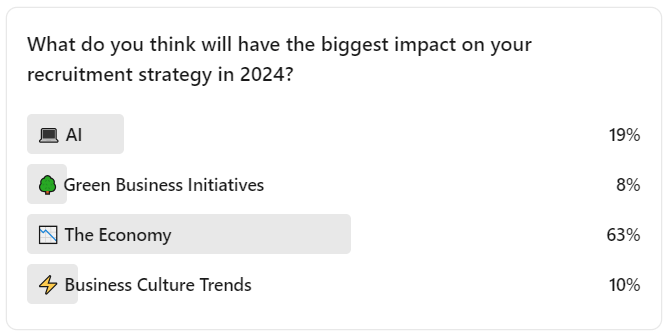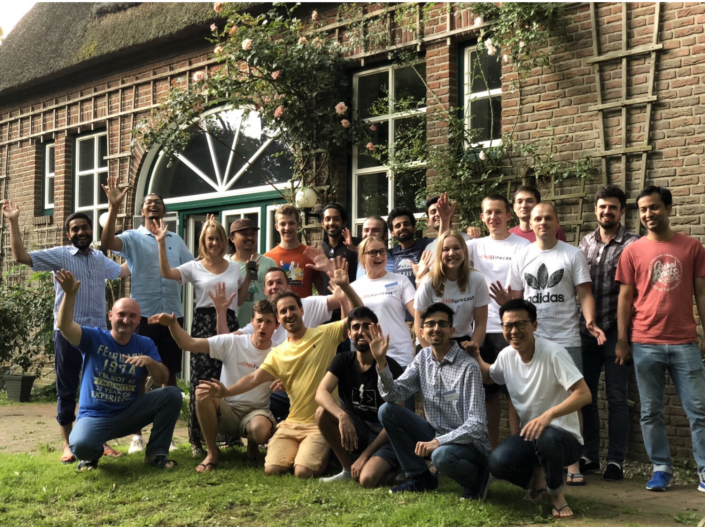Identifying and addressing the challenges of hard-to-fill jobs in 2024
Companies are trying to establish job libraries and align them with corresponding skills. In addition to constructing skill libraries, which involve developing a common language for discussing skills, these companies encounter challenges filling specific vacancies. The swift changes in technology, the economy, and society further complicate this task. A Business Insider article shed light on the jobs predicted to be the hardest to fill this year, highlighting the urgent need for companies to adapt their hiring strategies. We also analyzed the HRForecast database and looked at which vacancies will be difficult to fill this year. Contrary to the common belief that only blue-collar or truck driving positions are hard to fill, management and specialized roles are also increasingly difficult for staff.
In the following sections, we’ll review the roles identified by Business Insider as particularly challenging to fill. We expand our analysis with hard-to-fill jobs sourced from the HRForecast database. We will also explore strategies for improving recruitment pipelines, cost optimization, and strategic workforce planning. But first, let’s see why there are challenges in filling specific job roles for 2024.
Key influences on corporate hiring strategies and challenges in filling specific job roles for 2024
The economy was the clear winner with over 60% of the vote, according to LinkedIn’s survey provided by Merje, of what they believe will have the biggest impact on their hiring plans for 2024.
Source: Merje
Thus, the recruitment area for companies in 2024 is likely to be influenced by several key factors, each with the potential to impact their strategies and plans significantly. Here are some of the most pivotal elements:
- Economic conditions. Economic conditions significantly impact recruitment strategies, with growth, inflation, and unemployment as key drivers. During economic expansion, some companies may increase hiring to meet rising demand. However, high inflation requires adjustments in salary offerings to maintain the attractiveness of positions, compensating for the diminished purchasing power. Conversely, high unemployment rates can lead to a larger pool of job seekers, but overhiring in optimistic times can force layoffs during downturns. Therefore, organizations should navigate these economic uncertainties with agility, employing flexible work arrangements, investing in employee skills development, and regularly adjusting salaries to remain competitive and resilient in varying economic climates.
- Technological advancements. The rapid pace of technological advancement, particularly in artificial intelligence (AI), machine learning, cybersecurity, and data analytics, is reshaping the labor market and demanding that companies adapt their workforce to remain competitive. A McKinsey report highlights significant occupational shifts and projects’ continued change because of digitization and healthcare demand. It suggests that roles requiring advanced digital skills may be hard to fill due to a shortage of qualified candidates, leading companies to invest more in sourcing talent with necessary tech skills or upskilling their current employees.
- Diversity, equity, and inclusion (DEI). In 2024, the emphasis on Diversity, Equity, and Inclusion (DEI) in the workplace is set to intensify, with companies recognizing its critical role in fostering innovation and mirroring the diverse global customer base. The challenges in implementing DEI strategies for specific job roles are multifaceted, encompassing the need to adapt to changing societal norms and legal requirements and ensuring a workforce that reflects global diversity. Addressing these complexities necessitates innovative recruitment, retention, and workplace culture practices to ensure equal opportunities for all candidates.
- Sustainability and corporate social responsibility (CSR). Sustainable development and corporate social responsibility (CSR) pose challenges in filling specific positions for 2024 due to the increasing complexity and specialization of skills required in these areas. For example, the chemical industry is evolving into sustainable practices; there is a growing demand for professionals with expertise in environmental chemistry, environmental regulations, and sustainable supply chain management. This demand exceeds the current supply of qualified candidates, making it difficult for companies to find the right talent to meet their sustainability goals.
- Changing demographics. The aging workforce in many countries, coupled with the entry of Generation Z into the job market, is shifting the demographics of the labor pool. Companies should adapt their recruitment strategies to appeal to a broader range of candidates, considering differing values, expectations, and working styles.
- HR challenges and talent scarcity. HR is evolving, with talent, economic, and supply chain issues continuing to present challenges. The phenomena such as the Great Resignation and the need for talent development highlight the importance of strategic talent management. This environment suggests that roles critical for talent acquisition and development may be particularly challenging, emphasizing the need for organizations to adapt to the changing framework.
- Workplace transformation. Gallup’s research indicates that workplace engagement and well-being are more influenced by how employees are managed than their work location. This shift in work dynamics, coupled with increased job responsibilities and restructuring, indicates that roles requiring adaptable management and leadership skills may struggle to fill as employers and employees navigate these new expectations.
10 roles employers may struggle to fill in 2024
A recent Business Insider analysis highlighted ten jobs expected to be particularly difficult to fill in 2024. These roles cover various industries, highlighting the diverse knowledge and skills in demand. From skilled social workers who provide critical support in communities to cybersecurity experts tasked with protecting digital assets in an increasingly online world, the list reflects today’s workforce’s changing priorities and challenges.
10 roles employers may struggle to fill in 2024 according to Business Insider
- Qualified social workers
- Multi-skilled maintenance engineers
- Quantity surveyors
- Cyber security experts
- Energy/carbon managers
- Engineering project managers
- Special educational needs teaching assistants
- Credit controllers
- Newly-qualified accountants
- Supplier relationship managers.
The HRForecast team analyzed job vacancies presented by Business Insider to determine their difficulty filling them. We aimed to establish a correlation with the results published above. Based on the research results, the hiring process for the above vacancies can last up to three months, making them difficult to fill in the company. These roles are spread across different sectors, illustrating the dynamic nature of employment needs in the current labor market. In addition to the ten occupations identified by Business Insider, we’d like to highlight additional careers that are expected to be in high demand:
- Project engineer
- Accountant
- Social worker.
These professions are expected to be pivotal in meeting the evolving demands of the workforce, underscoring the importance of adapting recruitment strategies to address these critical needs.
10 roles hard to fill in the insurance industry according HRForecast labor data
Our findings reveal an average hiring timeframe of about three months for these positions in the United States, aligning with external sources and underscoring the accuracy of our data.
The insurance industry stands at the forefront of global economic stability, offering crucial services that protect individuals and businesses against financial loss. HRForecast has identified a list of roles within the general sector and the insurance industry that employers are likely to find difficult to fill. This difficulty stems from a combination of factors, including the need for niche expertise, the competitive nature of the job market, and the specific demands of these roles. The following analysis provides a deeper dive into these roles, offering insights into why they are in high demand and the implications for the industry.
This synchronization between our data and external sources underscores the reliability of our findings:
- Investment analyst
- Risk management specialist
- Investment risk analyst
- Investor relations manager
- Legal specialist
- Underwriter
- Investment manager
- Actuarial specialist
- Trading analyst
- Insurance claims specialist
Particularly, positions such as investment risk analyst, actuarial specialist, and insurance claims specialist are projected to be particularly challenging to fill, with hiring durations extending beyond three to four months. It highlights the specialized nature of these roles and the critical need for skilled professionals in the insurance sector.
“HRForecast was a crucial element this year. Without it, we couldn’t have delivered on vital topics. Their data on time to hire is the most accurate you’ll find, a real game-changer for us.” – Dominik A. Hahn, Global Head of Group Talent Acquisition at Allianz (international insurance company).
The analysis of these lists reveals critical insights into the evolving job market and the sectors that are anticipated to face talent shortages in 2024. It underscores the need for strategic actions from multiple stakeholders, including employers, educators, and policymakers, to address these gaps through targeted training, recruitment strategies, and policy adjustments. As the job market continues to evolve, staying ahead of these trends will be crucial for maintaining economic stability and growth.
For stakeholders looking to understand the intricacies of hiring trends and challenges within the insurance sector, HRForecast offers an invaluable resource. By leveraging our data, industry professionals can better prepare for the demands of the labor market, ensuring their companies remain competitive and resilient in the face of change.
Empower your talent strategy with smartData
Explore future roles, core skills, and optimal placements for your business strategy. Learn how our leading workforce analytics platform, smartData, enables you to navigate the talent market successfully.
Tips from HRForecast on how to effectively fill job roles your organization struggles to fill in
Organizations should adopt a comprehensive and strategic approach to excel in challenging job roles. It involves diversifying the talent search, enhancing the employer brand, optimizing job descriptions, offering competitive compensation, refining the interview process, committing to talent development, fostering diversity and inclusion, leveraging external expertise, embracing the global talent pool, and maintaining engagement with candidates. Here’s how to do it effectively:
- Commit to talent development. smartPeople provides a platform for skills management and talent mobility, enabling you to develop internal talent for hard-to-fill roles. By offering continuous learning opportunities and upskilling initiatives, you attract candidates interested in growth and ensure your workforce is future-proof.
- Expand your talent search. Use smartData to gain insights into global workforce trends and identify the best locations for sourcing skills relevant to your business. This allows you to expand your talent search more strategically, leveraging data-driven insights to post job openings in channels most frequented by your ideal candidates.
- Elevate your employer brand. Utilize the data from smartData to highlight how your organization is ahead in adopting future-oriented business and operating models and showcase your commitment to developing future-proofed skills within your team. Sharing success stories and testimonials can now include how data-driven decisions have positively impacted your workforce and organizational growth.
- Optimize job descriptions. Leverage insights from smartData to understand evolving job roles and required skills, ensuring your job descriptions reflect the true nature of the role and highlight the skills that are in demand. This makes your job postings more attractive and relevant to potential candidates.
- Offer competitive compensation. Use smartData to benchmark your compensation packages against global standards and industry trends. This helps in offering competitive compensation packages that are attractive to top talent, including benefits and flexible work arrangements aligned with future workforce expectations.
- Refine the interview process. Incorporate smartPlan automated gap-closing proposals to identify specific skills and competencies that candidates must demonstrate, making your interview process more focused and efficient. This ensures a thorough evaluation of both technical and behavioral aspects.
- Foster diversity and inclusion. Utilize smartData to understand workforce trends across different demographics and incorporate these insights into your diversity hiring initiatives. This ensures your job postings and overall recruitment strategy are inclusive and appeal to many candidates.
- Leverage external expertise. Use the insights from smartData and smartPlan to work more effectively with specialized recruitment services, ensuring these agencies are aligned with your strategic workforce planning and are targeting the right talent pools based on data-driven insights.
- Embrace remote candidates. smartData’s insights into global hot spots for specific skills and job profiles enable you to tap into a global talent pool more effectively, making the case for considering remote candidates stronger by highlighting the benefits of a diverse and globally distributed team.
- Engage and feedback. Employ smartPeople to inform candidates about their application status and provide constructive feedback. This platform can help create a positive experience for candidates by ensuring they are engaged and informed throughout the recruitment process.
By integrating smartData, smartPlan, and smartPeople into these strategies, your organization can enhance its recruitment and talent development efforts with a data-driven, strategic approach aligned with future workforce trends and requirements.
Wrapping up
Navigating the complexities of talent acquisition requires more than a strategy — it requires understanding the roles that challenge your industry the most.
What are the hardest positions to fill in your domain? Ones that, if filled, could dramatically change the trajectory of your organization?
Discover the secrets to identifying and attracting these top talents. Transform your approach to recruiting and turn challenges into opportunities for innovation and growth.
Take the first step. Book a call and learn about tailored strategies for your organization‘s unique needs.
By integrating smartData, smartPlan, and smartPeople into these strategies, your organization can enhance its recruitment and talent development efforts with a data-driven, strategic approach aligned with future workforce trends and requirements.
Stay up to date with our newsletter
Every month, we’ll send you a curated newsletter with our updates and the latest industry news.




























 info@hrforecast.de
info@hrforecast.de
 +49 89 215384810
+49 89 215384810






